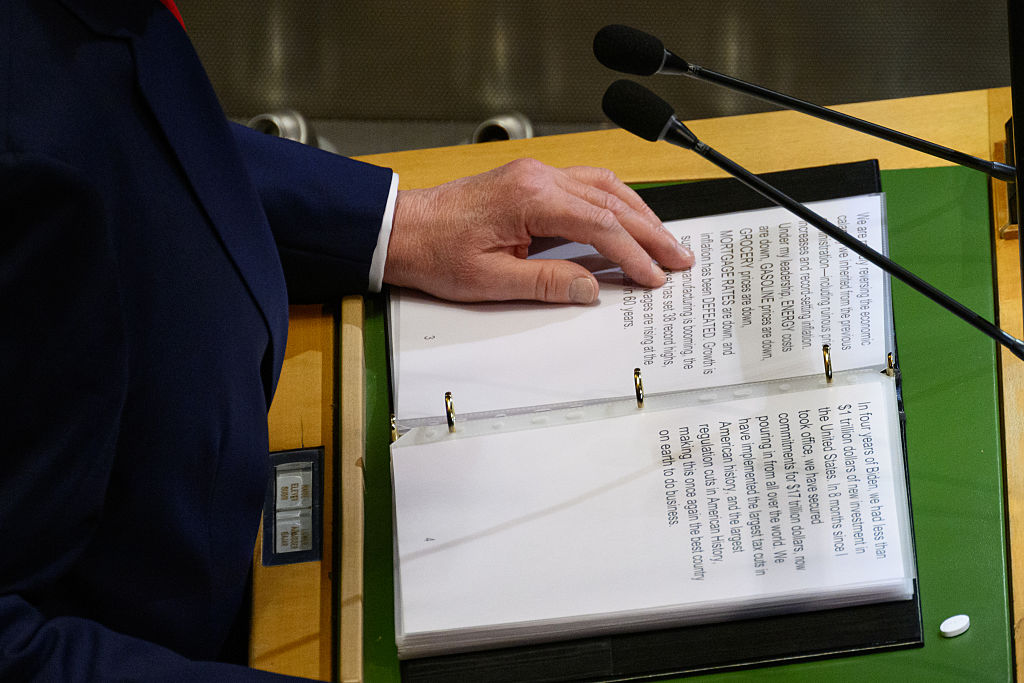This article is part of The D.C. Brief, TIME’s politics newsletter. Sign up here to get stories like this sent to your inbox.
In the last leg of the 2012 presidential campaign, the political world seemed to be subsumed by Republican nominee Mitt Romney’s caught-on-tape observation that roughly 47% of Americans don’t pay federal income taxes. The private remark reinforced a sense, even among conservatives, that the wealthy businessman was an out-of-touch elitist who was ready to write-off about half the country as indifferent to his economic agenda. In short, it confirmed the worst caricature of the former Massachusetts Governor and future Senator from Utah.
[time-brightcove not-tgx=”true”]
But here’s the rub: Romney was factually accurate about the statistic, even if his extrapolation that those millions of Americans view themselves as victims deserving of government hand-outs was dubious.
Fast forward to this week when President Donald Trump addressed world leaders at the United Nations on Tuesday and straight-up got provable facts wrong. He said “inflation has been defeated.” Nope. He said “grocery prices are down.” Nuh-uh. He said “our [electricity] bills are coming way down.” Absolutely not.
Objectively, none of this is true. Inflation has been worsening, hitting 2.9% last month compared to a year earlier. Grocery prices are up 2.7% in the same window. And electricity has jumped 6.2%
Looking back to when Trump took office in January—after campaigning on promising to quickly lower inflation and the cost of living—inflation has held steady, groceries are up 1%, and electricity is up 4.9%.
When asked on Wednesday if the President had any facts to back up the claims in his U.N. speech, the White House did not immediately respond.
Yet there stood Trump, blending his campaign rally showmanship with fact-free observations and petty asides as the presidents, prime ministers, and top diplomats of dozens of nations sat in mostly silence. He claimed he ended seven wars, some between countries that insist they were not at war. He claimed he has the highest poll numbers ever; public polling says otherwise. He claimed $17 trillion in foreign investments had come into the United States, a massive haul that was almost double the claim the White House made just one day earlier when the number was at $9 trillion (and even that figure is suspect). Those listening to the nearly hour-long speech also heard that Trump signed the largest tax cut in history and that hundreds of thousands of migrant children died or went missing under Biden, just a few of the debunked claims that Trump has been telling on a loop and repeated on Tuesday.
Sometimes facts actually don’t matter in politics. Former President Joe Biden presided over an economic turnaround that did not ring true to millions of Americans. Trump preached about an America in decline despite reams of evidence to the contrary. Feelings sometimes have more sway than facts.
And much like Biden before him, Trump is finding it difficult to talk his way past the country’s funk. Despite his cocky description of winning and winning and winning, Americans are less happy now than when Trump came back to power; Gallup had 34% of Americans saying they were satisfied with the nation’s direction, while the research firm published numbers this week that put the number back to 29%. Most of that drop off is because of Republicans souring on Trump, down from 76% last month to 68% now. And Trump’s approval rating has gone from 47% in January to 40% now. Put simply: Fewer Americans are buying the image of the nation that Trump is selling.
All politicians have elastic relationships with absolute truths. Neither party escapes the occasional smudge here, a rounding there. But as journalist Ryan Lizza observed over on his Substack right after Trump spoke: “His utterances sail freely between oceans of hyperbole, bullsh-t, and lies. When he occasionally arrives in a harbor of truth, it is merely by accident.” Ryan invoked a framing published by The New Republic last year that is a perfect descriptor for the type of gaslighting that unfolds as observers try to grapple with Trump’s glaring indifference to the truth: “sanewashing.”
It’s no secret that most Americans have a dim view of politicians, but Presidents historically have been a breed apart. Back in 1991—when President George H.W. Bush was in charge and Saddam Hussein was on the run—Gallup found 72% of Americans had a great deal or quite a lot of faith in the presidency. In 2002, in the wake of the 9/11 attacks, the presidency—occupied by George W. Bush—had a 58% marker on that question. These days, that same metric stands at 30%.
Just a year ago, every flub President Joe Biden made ricocheted as evidence of a man on the decline, a leader who should know better, a pol trying to pull a fast one on the nation. When Trump mangles knowable facts, it gets little more than a shrug. When he does it with world leaders as a captive audience, it merits just a shake of a head.
Now contrast that to the backlash from Romney’s “47%” comment, a moment Matt Rhoades, Romney’s campaign manager in 2012, called “the epitome of low during the course of the campaign.” The fallout translated into a full 2-point swing away from Romney; the drop was particularly pronounced among white men and young voters. One flub from Romney moved that campaign from a two-point race to almost five points behind Barack Obama. The nation has come a very long way from punishing a politician for being insensitive—but at least partly correct—on the underlying facts during a closed-door event to becoming numb to one who can’t bother to get the facts right while broadcasting a scripted address to a global audience hanging on his every word in real time.
Make sense of what matters in Washington. Sign up for the D.C. Brief newsletter.

